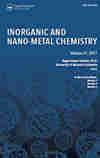Synthesis, Pyrolytic, and Antibacterial Study of 3-[(E)-(2-phenylhydrazinylidene)methyl]pyridine(PHMP) and Its Transition Metal Complexes
Synthesis and Reactivity in Inorganic, Metal-Organic, and Nano-Metal Chemistry
Pub Date : 2016-11-01
DOI:10.1080/15533174.2012.762682
引用次数: 1
Abstract
Phenyl hydrazine and pyridine-3-carbaldehyde were coupled to form a new Schiff base 3-[(E)-(2-phenylhydrazinylidene)methyl]pyridine(PHMP), followed by the formation of its transition metal derivatives (i.e., Co(II), Cu(II), and Zn(II) complexes). All of them were characterized by physical and spectral methods such as 1H-NMR, IR, elemental analysis, UV-Vis spectra, and conductance studies. Thermal study was carried out with TG/DTA method to understand the degradation pattern of the newly synthesized ligand and its complexes. Antibacterial study was carried out with both the gram-positive (Bacillus subtilis, Staphylococcus aureus, Staphylococcus epidermis, Streptococcus pneumonia) and gram-negative bacteria (Pseudomonas aeruginosa, Salmonella typhi, Escherichia coli). The complexes showed medium activity as compared to the standard imipenem.3-[(E)-(2-苯基肼基)甲基]吡啶及其过渡金属配合物的合成、热解及抗菌研究
苯基肼和吡啶-3-乙醛偶联形成新的希夫碱3-[(E)-(2-苯基肼基)甲基]吡啶(PHMP),然后形成其过渡金属衍生物(即Co(II), Cu(II)和Zn(II)配合物)。通过1H-NMR、IR、元素分析、UV-Vis光谱和电导研究等物理和光谱方法对它们进行了表征。采用热重分析/差热分析方法对新合成的配体及其配合物进行了热分析。对革兰氏阳性菌(枯草芽孢杆菌、金黄色葡萄球菌、表皮葡萄球菌、肺炎链球菌)和革兰氏阴性菌(铜绿假单胞菌、伤寒沙门氏菌、大肠杆菌)进行抑菌研究。与标准亚胺培南相比,该配合物的活性中等。
本文章由计算机程序翻译,如有差异,请以英文原文为准。
求助全文
约1分钟内获得全文
求助全文
来源期刊
自引率
0.00%
发文量
0
审稿时长
5 months

 求助内容:
求助内容: 应助结果提醒方式:
应助结果提醒方式:


